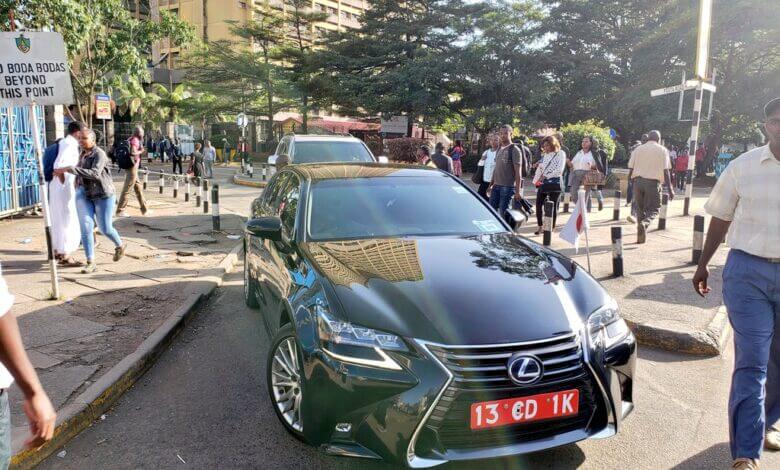In Kenya, the National Transport and Safety Authority (NTSA) oversees vehicle registration and transfer processes, ensuring compliance with legal and regulatory frameworks. For diplomats and embassies, vehicle transfers involve a unique set of requirements due to their diplomatic status, which grants certain privileges and exemptions. The process of transferring a vehicle from a diplomat to an embassy, known as the “NTSA forced transfer,” is a critical procedure that demands precision and adherence to specific protocols. This article provides a comprehensive guide to the NTSA forced transfer process for diplomats and embassies in Kenya, covering requirements, procedures, challenges, and practical insights for 2025. Whether you’re a diplomat, embassy staff, or a Kenyan citizen navigating this process, this guide will equip you with the knowledge to ensure a smooth and compliant transfer.
With Kenya’s growing role as a diplomatic hub in East Africa, hosting numerous embassies and international organizations, understanding the intricacies of diplomatic vehicle transfers is more important than ever. This article draws on credible sources, including NTSA guidelines, government regulations, and insights from recent discussions on platforms like X, to deliver an authoritative and engaging resource tailored to the Kenyan context.
What is the NTSA Forced Transfer for Diplomats and Embassies?
The NTSA forced transfer refers to the administrative process of transferring vehicle ownership from a diplomat to an embassy or mission in Kenya. Unlike standard vehicle transfers between private individuals, this process is governed by diplomatic protocols and requires approval from multiple government entities, including the Ministry of Foreign Affairs and the Kenya Revenue Authority (KRA). The term “forced transfer” is often used because it involves mandatory compliance with NTSA’s digital systems, such as the eCitizen platform, and specific documentation to maintain transparency and accountability.
This process is particularly relevant for diplomats leaving Kenya or transitioning roles, as well as embassies acquiring vehicles from diplomatic personnel. The requirements are designed to ensure that duty exemptions, a privilege granted to diplomats under international conventions like the Vienna Convention on Diplomatic Relations (1961), are properly managed and that vehicles are legally registered under the embassy’s name.
Why Are Diplomatic Vehicle Transfers Unique?
Diplomatic vehicle transfers differ from standard transfers due to the following factors:
- Duty Exemptions: Diplomats and embassies often import vehicles duty-free, which requires strict oversight to prevent misuse of this privilege.
- Diplomatic Status: Vehicles registered under diplomats or embassies carry special number plates (e.g., “CD” for Corps Diplomatique), requiring verification of diplomatic credentials.
- Regulatory Compliance: The NTSA, KRA, and Ministry of Foreign Affairs collaborate to ensure compliance with Kenyan laws and international agreements.
- Security Considerations: Vehicles owned by diplomats or embassies may require additional scrutiny for security and legal purposes, including clearance from the Directorate of Criminal Investigations (DCI).
These factors make the process complex, necessitating a clear understanding of the required documentation and steps.
Key Requirements for NTSA Forced Transfer From Diplomat to Embassy
The NTSA, in collaboration with the Ministry of Foreign Affairs and KRA, has outlined specific requirements for transferring a vehicle from a diplomat to an embassy. Below is a detailed list of the required documents, based on official guidelines and practical insights from 2025.
1. Request Letter from the Embassy or Mission
- A formal letter from the embassy or mission requesting the transfer of the vehicle.
- The letter must be addressed to the NTSA and include details such as the vehicle’s registration number, make, model, and the reason for the transfer.
- It should be signed by an authorized embassy official, typically the head of mission or administrative officer.
2. Form A (Approved by the Ministry of Foreign Affairs)
- Form A is a diplomatic vehicle registration form issued by the Ministry of Foreign Affairs.
- It confirms that the vehicle is eligible for diplomatic status and duty exemptions.
- The form must be completed and stamped by the Ministry before submission to the NTSA.
3. Form C (Approved by the Ministry of Foreign Affairs)
- Form C is a complementary document that verifies the transfer of ownership from the diplomat to the embassy.
- Like Form A, it requires approval from the Ministry of Foreign Affairs to ensure compliance with diplomatic protocols.
4. Customs Entry and Duty Payment Receipt
- Even though diplomats and embassies may be exempt from import duties, a customs entry document is required to confirm the vehicle’s legal importation.
- If any duties or taxes were paid (e.g., for non-exempt components), a receipt must be provided.
5. Tape Lift from the Directorate of Criminal Investigations (DCI)
- A tape lift is a forensic document that verifies the vehicle’s chassis and engine numbers.
- This is obtained from the DCI to ensure the vehicle’s identity and prevent fraud or tampering.
- The process involves a physical inspection of the vehicle at a DCI-approved facility.
6. Diplomatic ID for Both Buyer and Seller
- Both the diplomat (seller) and the embassy representative (buyer) must provide valid diplomatic IDs issued by the Kenyan government.
- These IDs confirm the diplomatic status of the individuals involved, which is critical for duty exemptions and NTSA approval.
7. KRA PIN for Both Buyer and Seller
- The Kenya Revenue Authority Personal Identification Number (KRA PIN) is required for both parties to ensure tax compliance.
- For the embassy, this may be the organization’s KRA PIN rather than an individual’s.
8. Pro 1B Form
- The Pro 1B form is a customs declaration form used to confirm the vehicle’s duty-free status or to document any applicable taxes.
- It must be completed and submitted to the KRA for approval before the transfer can proceed.
9. Pro 1C Form
- The Pro 1C form complements the Pro 1B form and is used to finalize the customs clearance process for diplomatic vehicles.
- It ensures that all customs requirements are met before the NTSA processes the transfer.
10. Organization/Embassy PIN
- The embassy or mission must provide its organizational KRA PIN, which is distinct from individual PINs.
- This verifies the embassy’s legal status as the new owner of the vehicle.
11. Original Logbook
- The vehicle’s original logbook, issued in the diplomat’s name, must be submitted to the NTSA.
- The logbook is updated to reflect the embassy as the new owner upon successful transfer.
Step-by-Step Guide to the NTSA Forced Transfer Process
Navigating the NTSA forced transfer process requires careful planning and coordination between the diplomat, embassy, and relevant authorities. Below is a step-by-step guide to ensure a seamless transfer.
Step 1: Prepare Documentation
- Gather all required documents listed above, ensuring they are complete and accurate.
- Verify that Forms A and C are approved by the Ministry of Foreign Affairs before proceeding.
- Obtain the tape lift from the DCI, which may require scheduling an inspection.
Step 2: Submit Customs Documents to KRA
- Submit the Pro 1B and Pro 1C forms, along with the customs entry and duty payment receipt (if applicable), to the KRA.
- The KRA will verify the vehicle’s duty-free status and issue clearance for the transfer.
Step 3: Access the NTSA eCitizen Portal
- Log in to the NTSA’s eCitizen portal (ecitizen.go.ke) to initiate the transfer process.
- Upload all required documents, including the request letter, Forms A and C, diplomatic IDs, KRA PINs, and the original logbook.
Step 4: Pay Applicable Fees
- While diplomatic transfers may be exempt from certain fees, administrative charges may apply.
- Check the eCitizen portal for the latest fee structure and make payments online.
Step 5: Await NTSA Approval
- The NTSA will review the submitted documents and verify compliance with diplomatic protocols.
- This process may take 7–14 business days, depending on the accuracy of the documents and the workload at NTSA offices.
Step 6: Collect Updated Logbook
- Once approved, the NTSA will issue a new logbook in the embassy’s name.
- Collect the logbook from the designated NTSA office or through the eCitizen portal.
Challenges and Solutions in Diplomatic Vehicle Transfers
Despite the structured process, diplomats and embassies may encounter challenges during the NTSA forced transfer. Below are common issues and practical solutions.
Challenge 1: Delays in Ministry Approvals
- Issue: The Ministry of Foreign Affairs may take time to approve Forms A and C, delaying the transfer process.
- Solution: Engage with the Ministry early, ensuring all forms are correctly filled and submitted. Follow up regularly to expedite approval.
Challenge 2: Incomplete Documentation
- Issue: Missing or incorrect documents, such as an invalid KRA PIN or an incomplete tape lift, can lead to rejection by the NTSA.
- Solution: Create a checklist of all required documents and verify their accuracy before submission. Consult with an NTSA officer if unsure about specific requirements.
Challenge 3: Technical Issues with eCitizen
- Issue: The eCitizen portal may experience technical glitches, hindering document uploads or payment processing.
- Solution: Ensure a stable internet connection and try accessing the portal during off-peak hours. Contact NTSA customer support for assistance if issues persist.
Challenge 4: Lack of Clarity on Duty Exemptions
- Issue: Confusion about duty exemptions can lead to delays or unexpected costs.
- Solution: Consult with the KRA’s customs department to confirm the vehicle’s duty-free status. Keep records of all customs-related correspondence.
Practical Tips for a Smooth Transfer
To ensure a hassle-free NTSA forced transfer, consider the following tips:
- Start Early: Begin the process at least 30 days before the intended transfer date to account for potential delays.
- Engage Professionals: Work with a clearing agent or legal expert familiar with diplomatic vehicle transfers to navigate complex requirements.
- Verify Diplomatic Status: Ensure that both the diplomat and embassy have valid diplomatic credentials to avoid rejection.
- Keep Digital Copies: Maintain digital and physical copies of all documents to streamline submissions and resolve disputes.
- Monitor Progress: Regularly check the eCitizen portal for updates on your application status.
The Role of NTSA and Government Agencies in 2025
The NTSA plays a central role in overseeing vehicle transfers, leveraging its digital platforms to enhance efficiency and transparency. In 2025, the authority continues to integrate advanced technologies, such as blockchain-based verification for logbooks, to prevent fraud and streamline processes. The Ministry of Foreign Affairs ensures compliance with diplomatic protocols, while the KRA safeguards tax exemptions and customs regulations.
Recent discussions on X highlight ongoing concerns about bureaucratic inefficiencies in government services, including vehicle transfers. For instance, posts have noted delays in passport processing and certificate issuance, suggesting broader systemic challenges that may affect diplomatic transfers. To address these, the NTSA has introduced helplines and online support channels to assist users, particularly diplomats unfamiliar with Kenyan systems.
The NTSA forced transfer from a diplomat to an embassy is a specialized process that requires meticulous attention to detail and compliance with Kenyan regulations. By understanding the required documents—such as the request letter, Forms A and C, customs receipts, and diplomatic IDs—and following the step-by-step guide, diplomats and embassies can navigate the process with confidence. Despite challenges like delays or technical issues, proactive preparation and engagement with relevant authorities can ensure a smooth transfer.
As Kenya continues to strengthen its position as a diplomatic hub, the NTSA’s role in facilitating vehicle transfers remains critical. By staying informed and leveraging digital tools like the eCitizen portal, stakeholders can achieve compliance and efficiency in 2025. For further assistance, visit the NTSA website (ntsa.go.ke) or contact their customer support team.





